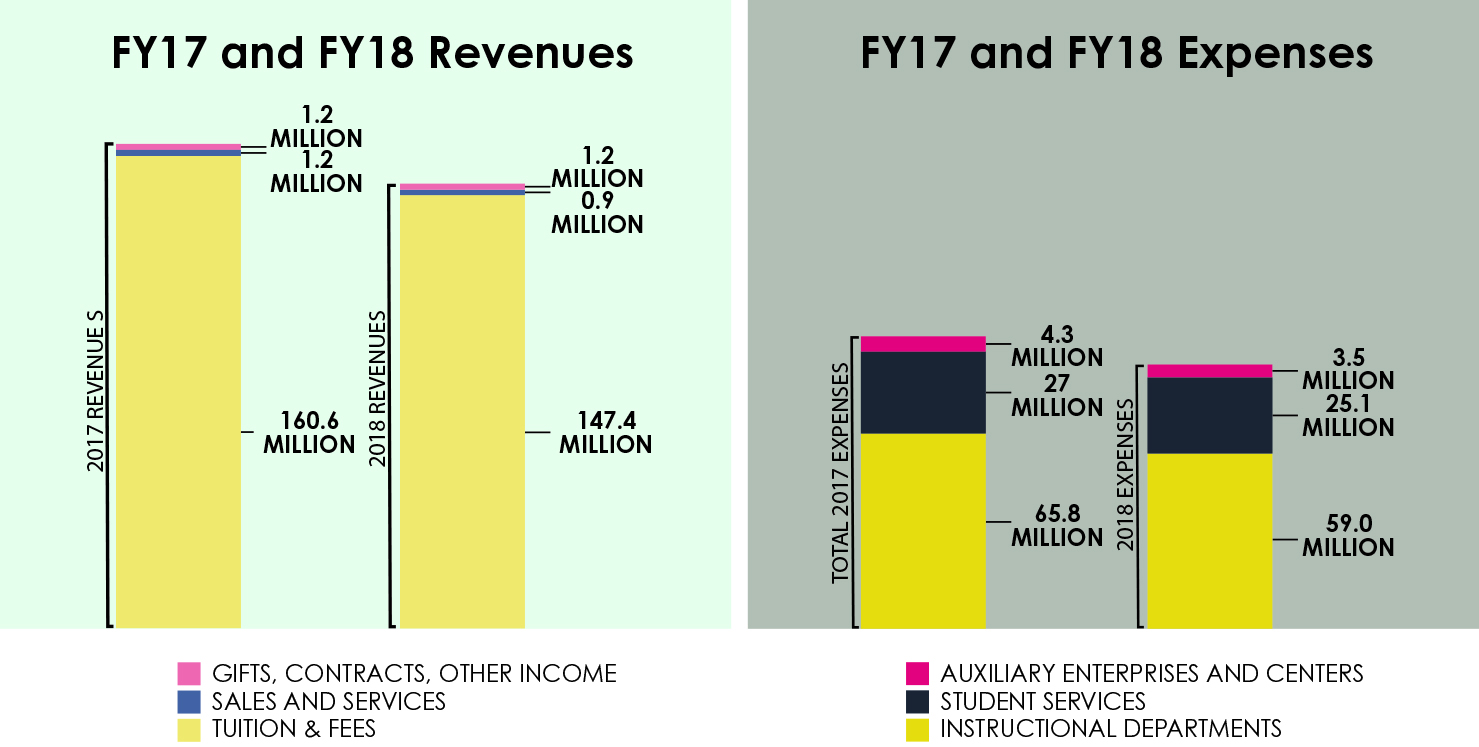College budget announced, shows cuts
November 20, 2017

College budget announced, shows cuts
The college’s Fiscal Year 2018 budget, published Oct. 31, is $187.7 million—down 7 percent from the $202 million FY17 budget—driven by the college’s falling enrollment.
The budget went into effect in September and was based on revenue projections made last spring.
Columbia was able to accurately predict necessary budget reductions last spring for the first time, according to Senior Vice President and Provost Stan Wearden, adding that it is an achievement for the whole college.
“[Predicting] was a great thing for us because we were able to establish a budget in the spring that ended up being the actual budget we used in the fall,” Wearden said.
Wearden explained the reason for the budget decrease is mainly the decline in student enrollment.
Vice President of Business Affairs and CFO Jerry Tarrer said from FY17 to FY18, student enrollment declined from 8,225 to 7,309 students.
“It’s entirely attributable to the enrollment decline,” Wearden said. “When we get less revenue because we have lower enrollment, we have less money to pay the bills, so we have to reduce our expense budget accordingly.”
Despite cuts to other budget areas, funds for Academic Administration increased from $11 million in 2017 to $15.7 million in 2018.
Tarrer said a large portion of the increase comes from the transfer of college recruiters from Student Services to Academic Administration, such as the Global Education Office and the School of Graduate Studies.
Auxiliary Enterprises and Centers, which funds organizations like ShopColumbia and the Museum of Contemporary Photography, was cut from $4.3 million in 2017 to $3.5 million for 2018.
Ronda Payne, director of Student Spaces and Retail Strategies for the Department of Exhibition and Performance Spaces, said cuts in the fall budget led to ShopColumbia losing one staff position. The shop’s fewer staff members meant fewer hours, including closing for evenings during the weekday, and closed on Saturdays. This has hindered its overall revenue, she noted.
Associate Dean of Student Life Kari Sommers said ShopColumbia initially opened in 2008 with only one employee. After it moved from 623 S. Wabash Ave. to 619 S. Wabash Ave. in 2016, a new employee was added, but with the recent cut, it is back to the way it was initially, she added.
“[The cuts have] affected our ability to partner with [other] departments,” Payne said. “We’re part of the Department of Exhibitions [and Performance Spaces], and in the past, we’ve been able to share marketing resources, placing advertisements together and also sharing staffing resources. Because they’ve experienced budget cuts, there’s less resources for us to share.”
Funding for instructional departments, which supports faculty and staff costs, dropped from $65.8 million in 2017 to $59 million for 2018.
Tarrer said the student enrollment drop caused less demand for instructors because fewer course sections are needed.
The college recently offered a buyout of employees to reduce expenses and workforce because of the school’s financial status, as reported March 6 by The Chronicle.
Prexy Nesbitt, adjunct professor in the Humanities, History and Social Sciences Department, said he thinks the department cuts have also contributed to the loss of faculty positions that have occurred throughout the college.
“The priority has to be on the quality of teaching and respecting the [adjunct] faculty,” Nesbitt said. “We’ve done the majority of the teaching for this institution, and certainly we need to be respected. It’s a question of respecting the students too, respecting their process of education and giving them the best.”
Students services, which includes admissions, the Career Center, Student Financial Services and student life offices, was reduced from $27 million in 2017 to $25.1 million this year.
Sommers said although decreases in budget are not necessarily positive, they are not strictly negative either, which is forcing the administration to make sure students do not feel the effects of budget cuts.
“This is strategically the right approach; it’s sound, and it puts the institution on a stronger financial footing than we’ve been in a long time,” Sommers said.
Tarrer said the administration was aware of the budget cuts before the semester and planned accordingly.
“As we were going through the budget development for this year and speaking with the provost and deans, they were aware of the impact, and they were as cautiously as possible managing this budget cut effectively,” Tarrer said.







